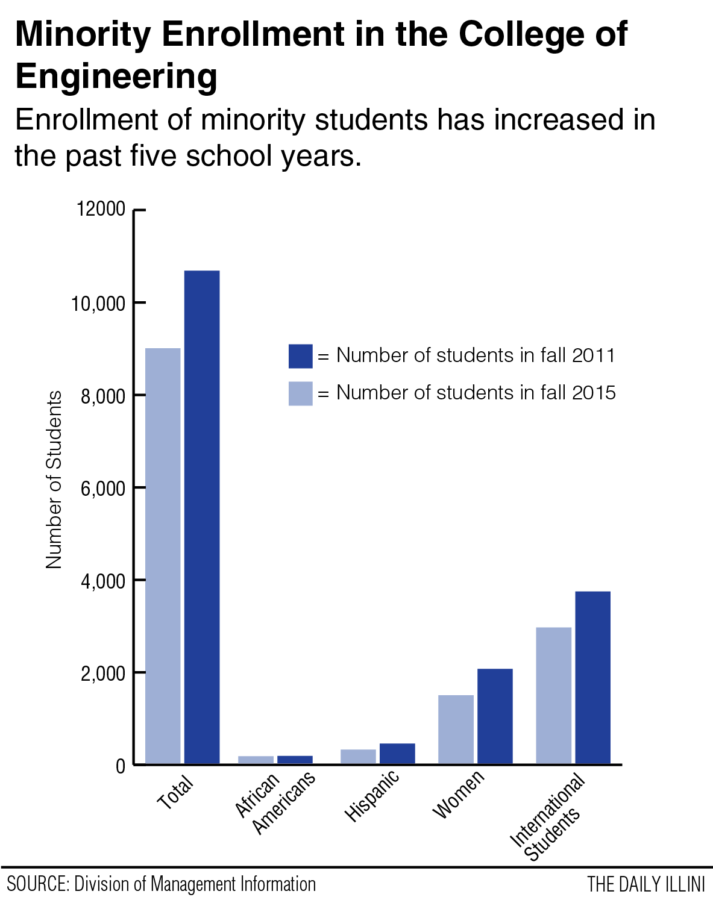Engineering reaches out to youth
Correction: A previous version of this graphic incorrectly labeled the x-axis of the bar graph as the number of freshmen enrolled in Engineering. The graphic should have been labeled to convey the enrollment numbers reflect the whole college. Additionally, the graphic incorrectly inflated the number of African American students enrolled in Engineering. The Daily Illini regrets the error.
Sep 29, 2015
Last updated on May 5, 2016 at 09:17 p.m.
The College of Engineering hopes to use specialized outreach and the implementation of new programs to attract a more diverse student population, and they’re trying to build their future classes early on.
“It is important what we do to engage more and more students, as early as possible, from underrepresented groups, said Andreas Cangellaris, dean of Engineering. “(It’s important to) have them thinking about and getting excited about engineering,”
Cangellaris said students need to start thinking about the competitiveness of engineering as early as possible and how difficult it may be to succeed. He said middle schools and high schools are aiming to better prepare students who may be interested in pursuing engineering.
Kevin Pitts, professor in physics, said some students don’t have the proper resources to help them prepare for the rigorous courses that engineering offers.
“The biggest thing is the problem of unequal opportunity,” he said. “Students who are living in lower socioeconomic areas do not have the opportunities that students who are living in richer areas do. We’re trying to focus on what we can do to help students be better prepared and level the playing field.”
The college offers two programs to give students the opportunity to be more involved in engineering.
Pitts said the college of Engineering partnered with a non-profit organization in Chicago to engage underrepresented middle school students in STEM fields. He said about half of the students are African-American and the other half are Hispanic students. He said the college also works directly with teachers to help them better prepare the students and understand the latest breakthroughs in math and science education.
The college is also developing the Red Shirt Program, which will offer resources for success to students who may be behind due to extenuating circumstances.
Pitts said the program will initially involve 30 students who have been accepted to the University who are hard working, have potential and show an interest in being engineers or scientists. It will be a five year program targeted at students from lower socioeconomic backgrounds and underrepresented groups who didn’t receive the proper preparation to succeed in engineering in high school.
“We have a group of students, with lots of mentoring, and a set of courses they’re going to take together so they can kind of build a community, so they can work together to get through this program,” he said.
Scholarships such as the Engineering Visionary Scholarship Endowment Fund may provide students interested in the Red Shirt Program with the ability to afford college.
Cangellaris stressed the importance of scholarships and said the college would not have increasing enrollment numbers without scholarships.
Kendall Riechman, junior in Engineering, said she is taking an engineering class with students from Spain. She said the students talk about ideas and topics she never would have thought about if they hadn’t said it.
“It’s just cool to see all the different perspectives and how everyone comes here to receive an education,” Riechman said.
The college is putting forth new ideas and methods to attract students from a variety of backgrounds to come to the University.
“We want to make sure that representation of our society is in everything we do, in everything that we design, in everything that we think about,” Cangellaris said. “It’s very important for every member of the society to have representation and that helps the way the society goes about its future.”
Pitts said the college has increased efforts to attract a more diverse array of students specifically in terms of race, gender and geographical location to bring more skills and ideas to the University.
“It’s been shown through numerous studies that bringing together people with different backgrounds, and different histories, cultures, identities, ideas makes for a better environment,” he said. “So when it comes to solving hard problems, the more diverse the group of people that is attacking that problem, the more creative the solutions are.”






